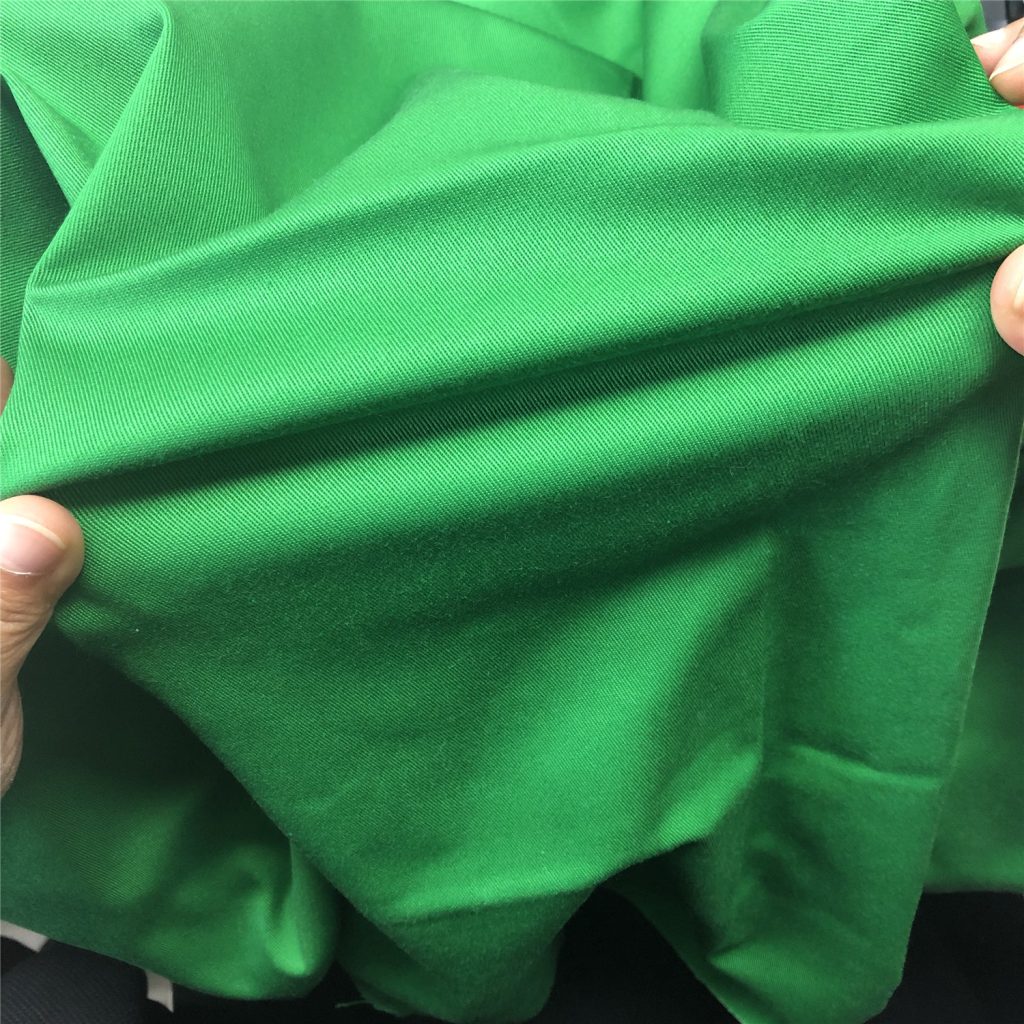In today’s demanding work environments professionals need clothing that is tough comfortable and flexible. Stretch workwear fabrics are the answer. They combine elasticity strength and functionality. They are perfect for industries like construction healthcare and outdoor work. They provide flexibility without sacrificing durability. In this article we’ll look at the key features and benefits of stretch workwear fabrics.
Stretch workwear fabrics are designed to be flexible.They use fibers like elastane (Lycra or Spandex) that stretch and recover. This allows freedom of movement without losing shape or durability. They are perfect for physically demanding work. Some like NORSelast® are known for high tensile strength. This makes them perfect for heavy-duty environments. They are comfortable durable and versatile. They are essential for many industries. They allow workers to move freely while staying protected.
The Role of Elastic Fibers in Stretch Fabrics
Stretch workwear fabrics stretch because they contain elastic fibers. These fibers allow the fabric to expand and then recover its shape after movement. The choice of elastic fibers determines how the fabric performs how elastic it is and how comfortable it is. Here are some of the most common elastic fibers used in stretch workwear fabrics:
- Spandex (Elastane/Lycra): Spandex is the most well-known elastic fiber. It stretches and recovers. It has an elasticity of over 14%. It is used in workwear fabrics where a high degree of stretch is required. For example it is used in healthcare and active industries. It allows the fabric to stretch a lot without losing its shape. This makes it perfect for physically demanding jobs where freedom of movement is required.
- T400: T400 fiber is a type of multi-component polyester fiber. It offers moderate stretch and enhances the fabric’s recovery properties. It has a similar elasticity to Spandex (over 14%). It is more durable and more resistant to wear. This makes it perfect for workwear that needs to be both flexible and resilient. For example it is used in construction or heavy machinery operations.
- Sorona: Sorona is a bio-based polyester fiber. It is soft stretches and recovers. It has over 14% elasticity. It is often chosen for its sustainable properties. It is used by environmentally conscious brands. It blends well with other fibers like cotton or polyester. It enhances the comfort and stretch of workwear fabrics.
- XLA: XLA is an elastic fiber. It has slightly less stretch than Spandex or T400. It ranges from 10% to 14% elasticity. It is chosen for its durability in extreme temperatures. It is also chosen for its chemical resistance. It is used in high-performance fabrics. For example it is used in industrial laundries or workplaces with chemical exposure.
- PBT (Polybutylene Terephthalate): PBT offers similar elasticity to XLA around 10% to 14% and is often used in fabrics that need moderate stretch combined with high strength. It provides good resistance to chlorine and is commonly used in garments for industries like sanitation and healthcare where fabrics are frequently exposed to harsh cleaning agents.
Common Stretch Fabric Compositions for Workwear
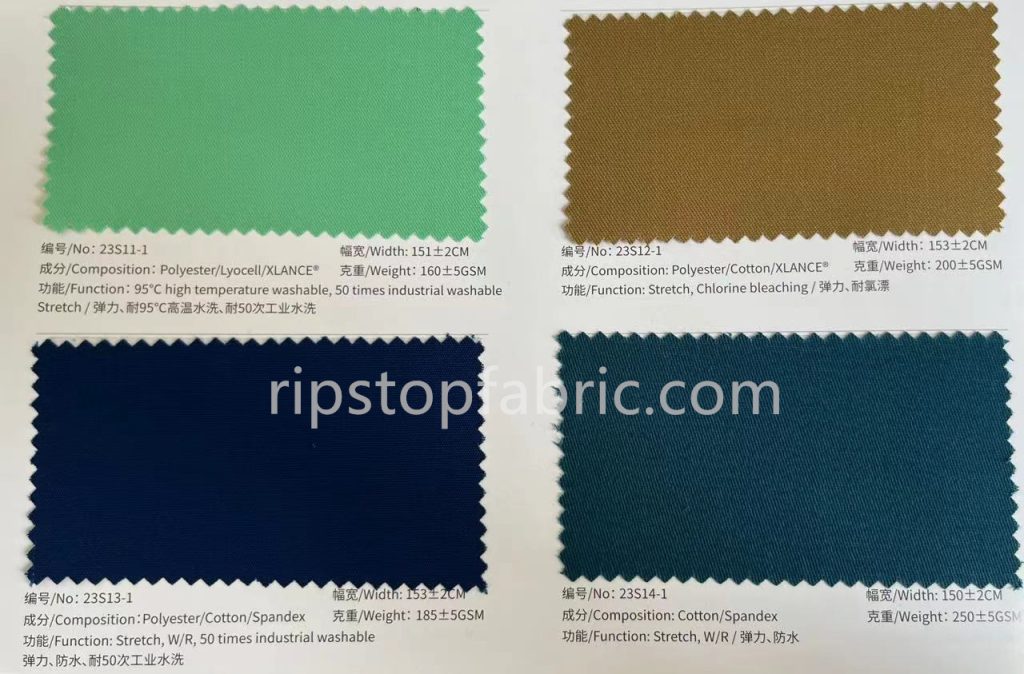
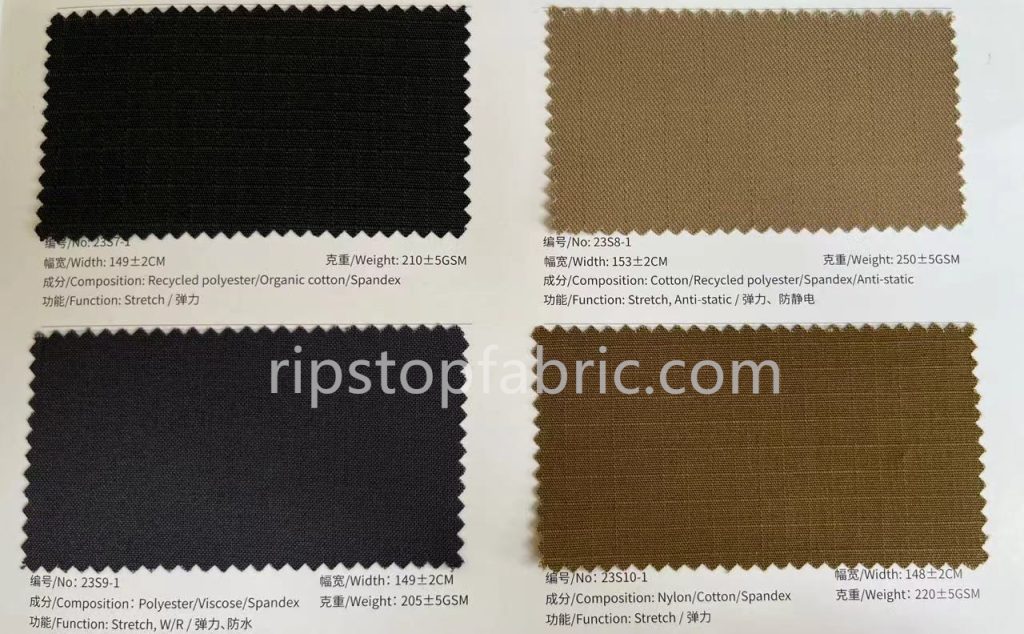
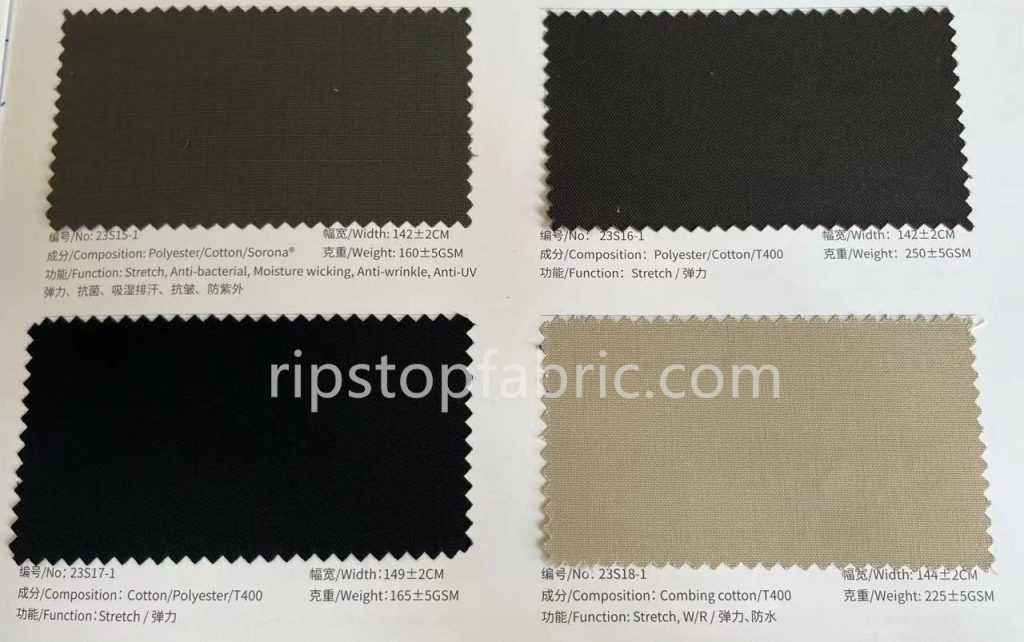
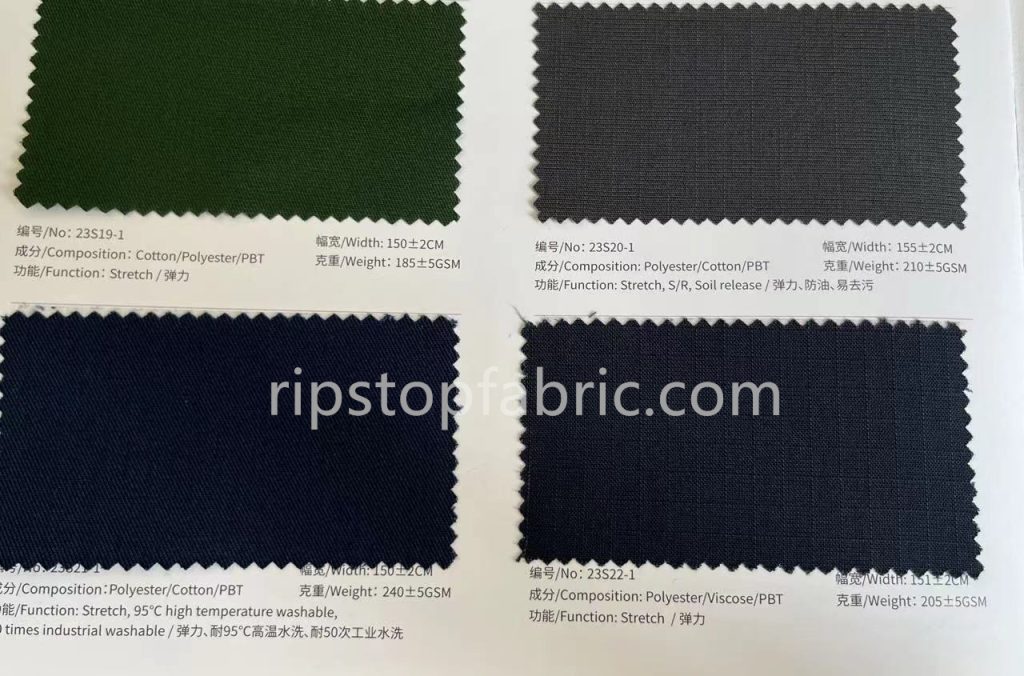
Stretch fabrics used in workwear come in a variety of compositions to meet the diverse needs of different industries. Here are some of the most common stretch fabric blends and their benefits:
- Polyester/Cotton Stretch Fabric: This blend combines the strength and durability of polyester with the breathability and comfort of cotton. A typical composition might be 65% polyester and 35% cotton offering a balance of resilience and comfort. It is suitable for industries like construction and manufacturing where workers need long-lasting fabrics that can withstand tough conditions.
- Polyester/Viscose Stretch Fabric: This fabric blend mixes the durability of polyester with the softness and moisture-wicking properties of viscose. It is an excellent choice for industries such as healthcare and hospitality where comfort and flexibility are essential. By incorporating elastane fibers like Spandex or T400 this fabric can provide stretch while maintaining its strength.
- Cotton/Nylon Stretch Fabric: Cotton and nylon blends offer a combination of comfort and superior abrasion resistance. Nylon increases the fabric’s durability making it ideal for jobs that require rugged workwear such as mechanics or outdoor trades where fabrics need to endure harsh environments without sacrificing comfort.
- Polyester/Lyocell Stretch Fabric: This blend leverages the strength of polyester and the eco-friendly and moisture-absorbing qualities of Lyocell. Lyocell fibers are soft breathable and have excellent moisture management properties making this blend a great choice for sustainable workwear that doesn’t compromise on performance.
- Cotton Stretch Fabric: In cotton fabrics the addition of elastic fibers like Spandex helps create flexibility without sacrificing the natural comfort of cotton. This type of fabric is highly breathable and comfortable making it ideal for industries that prioritize both movement and comfort such as outdoor work and healthcare.
Women’s Stretch Workwear Fabric: What to Consider
When designing women’s workwear you need to think about comfort and fit. Women’s workwear requires fabric that stretches and adapts to different body shapes. Here’s what you need to know:
- Form-Fitting and Adaptive Designs: For women’s stretch workwear you want fabric like Spandex and Sorona that has a lot of stretch and recovery. These fabrics are flexible and keep their shape so the clothes look good and feel good even when women wear them for long hours.
- Breathability and Moisture Management: If women work in hot environments you want to use breathable blends like polyester/cotton with bamboo fiber. These fabrics help keep them cool and dry by wicking away moisture.
- Sustainability: A lot of women’s workwear brands are looking for sustainable options. You can use recycled polyester or organic cotton in these fabrics to make them eco-friendly without sacrificing performance. This aligns with the trend of environmental responsibility.
Men’s Stretch Workwear Fabric: Durability and Comfort
When you design men’s workwear you often focus on durability especially for jobs that are physically demanding. However you also need to think about comfort. Here’s what you need to know about stretch fabrics for men’s workwear:
- Reinforced Durability: You want to use fabric like cotton/nylon or polyester/cotton blends that are really tough for rugged environments. These fabrics are abrasion-resistant so the clothes can stand up to physically demanding jobs like construction mining or metalwork.
- Enhanced Flexibility: You can add fibers like T400 or XLA to men’s workwear to make it more flexible without sacrificing toughness. This allows tradesmen to move freely whether they’re climbing scaffolding or bending and crouching throughout the day.
- Functional Finishes: Many men’s workwear fabrics come with additional finishes like wrinkle resistance high-temperature washability or UV protection. These finishes make the fabric suitable for harsh outdoor environments or industrial laundries.
Functional Finishes for Stretch Workwear Fabric
You can also add different functional finishes to stretch workwear fabric to make it more suitable for specific industries. Here are some of the key finishes:
- Industrial Wash Resistance: If you’re making fabric for industries like construction or heavy machinery you need to make sure it can stand up to frequent high-temperature washes. You can add an industrial wash resistance treatment to the fabric to help it keep its strength and appearance after multiple wash cycles.
- Moisture-Wicking and Breathability: If people are going to be working in hot environments you want to add treatments that help with moisture management and breathability. Moisture-wicking treatments help keep people dry especially in industries like healthcare and hospitality.
- UV Protection and Water Resistance: If you’re making outdoor workwear you can add treatments like UV protection and water resistance to help protect people from the sun and rain. These treatments are especially important for industries like construction or agriculture where people spend a lot of time outside.
- Stain Resistance and Anti-Wrinkle: In industries like hospitality or healthcare you want to add treatments to the fabric that help it resist stains and wrinkles. This way people’s uniforms look professional and clean all day long. Additionally three-proof treatments (waterproof oilproof stain proof) are essential for industries like food services and sanitation.
Choosing the right manufacturer
Choosing the right manufacturer is crucial to getting the best fabric for your workwear needs. Here’s a step-by-step guide to make this process as smooth as possible:
- Define Your Requirements: The first step is to clearly outline your needs. You should have an original fabric sample that reflects the texture stretch and durability you are looking for. This helps the manufacturer analyze important aspects such as yarn count density and weave method. You should also have a specification sheet that details requirements like color fastness shrinkage strength and stretch. Having these documents ready will significantly reduce the chances of miscommunication.
- Finding the Right Manufacturer: Use all available resources whether through trade shows online directories or industry recommendations to find a manufacturer with expertise in stretch workwear fabrics. The sales representative you engage with should be knowledgeable patient and responsive. This process may take time as you’ll likely need to communicate with multiple manufacturers before finding the right fit.
- Submit Your Requirements and Request Samples: Once you’ve found a suitable manufacturer submit your specifications and request a quote and fabric samples. If your original sample is common the manufacturer may quickly find similar or identical samples speeding up the process. In this case you can move swiftly to sample testing approval and production. If your fabric needs are more customized the manufacturer may need to create a sample from scratch. This can take between 7 to 45 days depending on the complexity and might incur additional costs. Once the sample is approved you can proceed with production.
By following this process you’ll get the fabric that meets your exact requirements resulting in high-quality workwear that performs well in demanding conditions.
Benefits of Cotton-Rich Fabrics in Workwear
Cotton-rich fabrics offer an excellent balance between comfort and durability. In physically demanding industries these fabrics offer breathability helping workers stay cool and comfortable during long shifts. When blended with fibers like polyester or viscose they retain the strength needed to endure frequent movement and wear while maintaining a soft feel against the skin. These qualities make cotton-rich fabrics particularly suitable for both industrial and outdoor workwear where comfort and functionality must go hand in hand.
Summary
Stretch workwear fabrics offer industry professionals unmatched comfort and durability. Whether you’re looking for high-stretch options like elastane or durable blends for tough environments these fabrics ensure flexibility and protection. By choosing the right materials and working with the right manufacturer companies can enhance worker performance and satisfaction.

